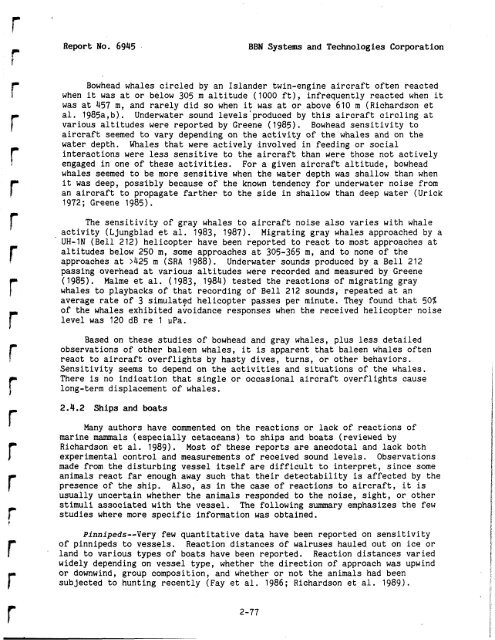Analysis and Ranking of the Acoustic Disturbance Potential of ...
Analysis and Ranking of the Acoustic Disturbance Potential of ...
Analysis and Ranking of the Acoustic Disturbance Potential of ...
Create successful ePaper yourself
Turn your PDF publications into a flip-book with our unique Google optimized e-Paper software.
Report No. 6945<br />
BBN Systems <strong>and</strong> Technologies Corporation<br />
Bowhead whales circled by an Isl<strong>and</strong>er twin-engine aircraft <strong>of</strong>ten reacted<br />
when it was at or below 305 m altitude (1000 ft), infrequently reacted when it<br />
was at 457 m, <strong>and</strong> rarely did so when it was at or above 610 m (Richardson et<br />
al. 1985a,b). Underwater sound levels'produced by this aircraft circling at<br />
various altitudes were reported by Greene (1985). Bowhead sensitivity to<br />
aircraft seemed to vary depending on <strong>the</strong> activity <strong>of</strong> <strong>the</strong> whales <strong>and</strong> on <strong>the</strong><br />
water depth. Whales that were actively Involved in feeding or social<br />
interactions were less sensitive to <strong>the</strong> aircraft than were those not actively<br />
engaged in one <strong>of</strong> <strong>the</strong>se activities. For a given aircraft altitude, bowhead<br />
whales seemed to be more sensitive when <strong>the</strong> water depth was shallow than when<br />
it was deep, possibly because <strong>of</strong> <strong>the</strong> known tendency for underwater noise from<br />
an aircraft to propagate far<strong>the</strong>r to <strong>the</strong> side in shallow than deep water (Urick<br />
1972; Greene 1985).<br />
The sensitivity <strong>of</strong> gray whales to aircraft noise also varies with whale<br />
activity (Ljungblad et al. 1983, 1987). Migrating gray whales approached by a<br />
UH-IN (Bell 212) helicopter have been reported to react to most approaches at<br />
altitudes below 250 m, some approaches at 305-365 m, <strong>and</strong> to none <strong>of</strong> <strong>the</strong><br />
approaches at >425 m (SRA 1988). Underwater sounds produced by a Bell 212<br />
passing overhead at various altitudes were recorded <strong>and</strong> measured by Greene<br />
(1985). Malme et al. (1983, 1984) tested <strong>the</strong> reactions <strong>of</strong> migrating gray<br />
whales to playbacks <strong>of</strong> that recording <strong>of</strong> Bell 212 sounds, repeated at an<br />
average rate <strong>of</strong> 3 simulat$d helicopter passes per minute. They found that 50%<br />
<strong>of</strong> <strong>the</strong> whales exhibited avoidance responses when <strong>the</strong> received helicopter noise<br />
level was 120 dB re 1 pPa.<br />
Based on <strong>the</strong>se studies <strong>of</strong> bowhead <strong>and</strong> gray whales, plus less detailed<br />
observations <strong>of</strong> o<strong>the</strong>r baleen whales, it is apparent that baleen whales <strong>of</strong>ten<br />
react to aircraft overflights by hasty dives, turns, or o<strong>the</strong>r behaviors.<br />
Sensitivity seems to depend on <strong>the</strong> activities <strong>and</strong> situations <strong>of</strong> <strong>the</strong> whales.<br />
There is no indication that single or occasional aircraft overflights cause<br />
long-term displacement <strong>of</strong> whales.<br />
2.4.2 Ships <strong>and</strong> boats<br />
Many authors have commented on <strong>the</strong> reactions or lack <strong>of</strong> reactions <strong>of</strong><br />
marine mammals (especially cetaceans) to ships <strong>and</strong> boats (reviewed by<br />
Richardson et al. 1989). Most <strong>of</strong> <strong>the</strong>se reports are anecdotal <strong>and</strong> lack both<br />
experimental control <strong>and</strong> measurements <strong>of</strong> received sound levels. Observations<br />
made from <strong>the</strong> disturbing vessel itself are difficult to interpret, since some<br />
animals react far enough away such that <strong>the</strong>ir detectability is affected by <strong>the</strong><br />
presence <strong>of</strong> <strong>the</strong> ship. Also, as in <strong>the</strong> case <strong>of</strong> reactions to aircraft, it is<br />
usually uncertain whe<strong>the</strong>r <strong>the</strong> animals responded to <strong>the</strong> noise, sight, or o<strong>the</strong>r<br />
stimuli associated with <strong>the</strong> vessel. The following summary emphasizes <strong>the</strong> few<br />
studies where more specific information was obtained.<br />
Pinnipeds--Very few quantitative data have been reported on sensitivity<br />
<strong>of</strong> pinnipeds to vess.els. Reaction distances <strong>of</strong> walruses hauled out on ice or<br />
l<strong>and</strong> to various types <strong>of</strong> boats have been reported. Reaction distances varied<br />
widely depending on vessel type, whe<strong>the</strong>r <strong>the</strong> direction <strong>of</strong> approach was upwind<br />
or downwind, group composition, <strong>and</strong> whe<strong>the</strong>r or not <strong>the</strong> animals had been<br />
subjected to hunting recently (Fay et al. 1986; Richardson et al. 1989).
















